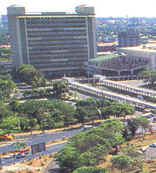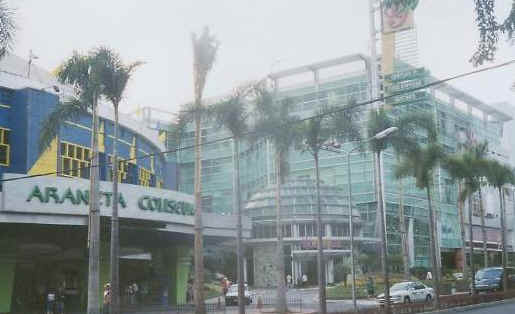| All
About: Quezon City |
|
OVERVIEW |
|

|
|
Quezon
City is the largest city of Metro Manila's cities in
population and land area. Over 2.17 million now live
here, most of them young. About one-third or 32% of our
population is less than 15 years old. Our youthful
population has given us a labor pool of 997,000 people,
a human resource asset that can empower definitely much
more than the 55,000 establishments located in the city
at present.
We
found that, despite the diversity in ages, incomes and
lifestyles, a common yearning runs through everyone in
Quezon City - that is, for a Quality Community where
people can live, work and do business in a hospitable,
progressive and peaceful environment.
Quick Facts about Quezon City
People
Quezon City has a population of 2,173,831 people, the
largest in Metro Manila. The population is spread over
four districts and 142 barangays. District II is the
most densely populated area.
Population
by Districts:
Population Distribution by
District:
District I
382,167
District II
942,074
District III
267,568
District IV
397,610
Average
annual population growth rate (1995 - 2000) is
1.92%. By the year 2005, it is estimated that
2,390,688 people would be living in Quezon City.
Other population statistics:
* Majority female at 52%, male at 48%
* Marital Status: 48% single, 47% married
* Generally young population with average age of 24
years old
* Population of working age (15 years old and older)
is 1,486,000 or 67% of total population
* Density - 135 persons/hectare
* People of Quezon City are of mixed regional origin
as they are mostly migrants from different parts of
the country
* Predominant Religion : Roman Catholic (99%)
Economy
Business in the city is dominated by small and
medium-scale establishments engaged mostly in the
distribution of finished products and the provision of
basic personal services. With a sizeable portion of
the city's land area being developed for commercial
and industrial ventures, complemented by the
availability of a large manpower pool, Quezon City has
great potential to support an increase in the number
of big businesses in the city.
Business statistics:
* No. of business establishments
(2001): 55,759
* Distribution of business
establishments, by industry:
o Wholesale and retail trade: 47%
o Manufacturers: 12%
o Hotels and restaurants: 13%
o Real estate, leasing & various
business
services: 8%
o Community, social and other personal services: 6%
o Others: 14%
Location, Land Area and Natural Features
Quezon City is at the northeastern portion of Metro
Manila. It has a land area of 16,112.12 hectares,
almost one-fourth of the National Capital Region (NCR)
and is the biggest among NCR's 12 cities and 5
municipalities. Situated on the Guadalupe Plateau, the
city's topography is largely rolling with alternating
ridges and lowlands. The southern region of the city
has low-grade terrain while the northern half is
undulating, culminating at the Novaliches Reservoir.
Served by a network of rivers and creeks, the city is
efficiently drained except for some portions which
experience flash floods due to the deterioration of
waterways.
The City shares an aquifer system with Metro Manila
which, due to overdrawing, has been subjected to
saltwater intrusion. Another feature which it shares
with the rest of the region is the Valley (Marikina)
Fault System traversing the city's eastern portion.
|
|
|
|
|
Take
the M.R.T. to go to MRT:
|
|
Leave your car home, avoid the heavy traffic plus drink all you can! From the Makati area, you're just 19 minutes away from the MRT Triangle
|
|
From the Taft,
Magallanes or Ayala (Makati) M.R.T. Stations, go down at
the GMA-Kamuning Station, which is just a few minutes'
walk away from the MRT Triangle.
|
|
Fare
(One-Way):
14 Pesos Last
trip back to Makati: 9:50 PM.
|
|
|
|
|
Present
Trends and Emerging Patterns
Land Use
The
City is predominantly residential, with
residential areas comprising 45.45% of its land
area. But it has retained its institutional
character with the presence of the Philippine
Congress, other national agencies, academic and
specialized medical institutions. The City also
has a large, open space system with the Ninoy
Aquino Parks and Wildlife,
Quezon Memorial
Circle and
UP Arboretum as the core, while the Novaliches
Watershed provides additional greenery.
Commercial growth is mainly sited along major
thoroughfares. Industrial development,
meanwhile is relatively contained in the
traditional industrial areas at Balintawak,
Novaliches, and Ugong Norte.
Transport and utilities
The
city is traversed by several major metropolitan
thoroughfares, namely C-3 (Araneta Avenue), C-4
(EDSA), C-5 (Katipunan - Luzon - Republic
Avenue), R-6 (Aurora Blvd.), R-7 (Quezon Avenue
- Commonwealth Avenue) and R-8 (Bonifacio Avenue
- Quirino Highway), which link the city to the
rest of Metro Manila. These thoroughfares are
supplemented by main and secondary intra-city
roads for area-wide mobility and by numerous
tertiary roads that provide access to minor
communities and individual properties.
Construction and completion of major transport
and infrastructure projects is expected to
trigger further development in the city. When
completed, the projects will increase the flow
of people and commerce throughout the city.
Ongoing projects include:
Additional LRT lines:
*
LRT Line 2 - fully elevated track utilizing
Aurora Blvd. alignment, from C.M. Recto to
Katipunan Ave.; has a length of 11.76 kms;
* LRT Line 3 - also known as EDSA MRT; its
extension from North Ave. main terminal to
Monumento (Caloocan) is about to commence.
* LRT Line 4 - from Quezon Avenue Mabuhay
Rotonda to Quirino Ave., using alignments of
Quezon Ave., Commonwealth Ave. and Regalado
Ave.; length is 18.35 kms;
Circumferential roads:
* Circumferential Road-4 (C-4). Planned
improvements along EDSA include the construction
of West / North Ave. Interchange and Roosevelt
Ave. Interchange.
* Circumferential Road-5 (C-5). An alternative
to EDSA utilizing the Katipunan
Ave.
*Luzon Ave., and
Republic Aveenue route, will be undertaken
through a build-operate-transfer scheme.
Local and other national road projects:
*Mindanao Avenue- extension from
Quirino Highway
to Gen.
Luis Ave. in Valenzuela.
* Improvement of Congressional Avenue -
extension from Visayas
Ave.
to Luzon
Ave.
* Inter-neighborhood Roads - construction of
connecting segments of identified community
roads to serve as alternate routes to
decongest major roads.
Water Supply
Like
the rest of Metro Manila, Quezon City gets its
water supply from MWSS and its private
distribution concessionaires, the Maynilad Water
Service Inc. (MWSI), serving the west half of
the city and Manila Water Co.(MWC) the east
portion
Power Supply
The electric power requirement of the city is
adequately serviced by the Manila Electric
Company or MERALCO. More than 97% of the city's
population have access to electricity. It
should, however, be noted that there are still
areas unserved by MERALCO such as in most parts
of Payatas mainly due to right-of-way and land
tenure problems.
Solid Waste Collection and Disposal
The city's Environment Protection and Waste
Management Department (EPWMD) reported that in
year 2000, the average daily collection volume
of garbage was 1,500 tons, that reflects per
capita waste generation rate of 0.69 kg. per
day. Garbage collected is disposed of at the
open dumpsite located in area I of Barangay
Payatas.
The city government is developing alternative
disposal modes that are environment-friendly,
through a Materials Recovery Facility (MRF).
Services and Facilities
Type of establishments & Number:
Public schools: 138
Elementary: 96
Secondary: 42
Private schools: 283
Public daycare centers: 190
Public hospitals: 18
Health centers: 54
Police force: 2,462
Fire fighting force: 434
Media centers:
Television networks: 6 major networks
Radio stations: 10
Print media offices: 5
National government offices: 125
Government-owned & controlled corporations:
25 |
|
|
|
| |

|
|
Gateway
Mall & Araneta Coliseum Cubao, Quezon
City |
|
Tourist
Belt
|
|
Quezon
City has its own tourist belt, found in the once quiet
district of Tomas Morató, Roces and Timog Avenues
plus a portion of Quezon Avenue which are now dotted
with luxurious and exquisite restaurants, disco houses,
night clubs, sauna clinics and other shops.
|
|
|
|

|
|
University
of the Philippines (U.P.)
|
|
On
12 February 1949, a motorcade made its way from Padre
Faura (Manila) all the way to a cogon-strewn expanse
in Quezon City. At its head, borne on an open vehicle, was
the "Oblation", the bronzed symbol of the
University of the Philippines, on its way to its new home.
This ceremony marked the university's transfer from its
original site in Manila (c. 1908) to its 493-acre campus
in Diliman, which would have more room for the
University's expansion as it fulfilled its role as
educator to the nation.
Fifty two years later, the main campus of the most
prestigious university in the Philippines is home to
diverse colleges, offering 94 graduate and undergraduate
courses as well as several centers of research, many of
which have been declared by the Commission on Higher
Education as National Centers of Excellence.
|
|
|
|
|